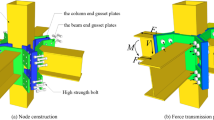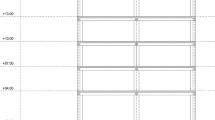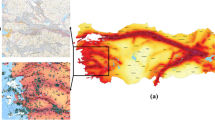Abstract
The steel shear wall has been introduced as a system with high stiffness and strength and a considerable capability in absorbing seismic energy. Due to its special advantages compared to other lateral load-resistant systems, this system is being used in tall buildings more and more frequently. Ductility and energy absorption are important parameters to be considered when choosing a robust lateral load-resistant system. By increasing the ductility and energy absorption of the structures, their seismic performance and safety are improved. Ideally, a structural system should provide both ductility and energy absorption in an economic way. This study presents the numerical simulation of the seismic behavior of a recently developed four-layer steel shear wall composed of corrugated and flat sheets. The simulations were performed using finite element software ABAQUS. Nonlinear static analysis was used to derive seismic parameters. The results showed that the corrugated sheets surrounded by flat sheets provide greater seismic parameters such as ductility and over-strength compared to double corrugated walls. According to the results, the calculated R-factor, displacement amplification factor, and the overstrength factor of the proposed wall were 4.58, 8.21, and 1.26, respectively. Furthermore, to use the seismic parameters of the shear wall, some relationships have been presented for incremental strength and stiffness coefficients without the need for finite element modeling. Compared to the finite element results, the presented relations had good accuracy.
Similar content being viewed by others
Abbreviations
- a :
-
Amplitude of corrugation
- b :
-
Width of the steel shear wall plate(SPSW)
- d :
-
Height of the SPSW
- d 0, d 1, d 2, d 3 :
-
Dimensions of the corrugation
- D x, D y, H :
-
Rigidity constants of the SPSW (N·mm)
- E :
-
Young’s modulus of steel material
- E d :
-
Disapiated energy
- E s :
-
Elastic energy
- F max :
-
Maximum base shear force per cycle
- F min :
-
Minimum base shear force per cycle
- F fu :
-
Shear capacity or ultimate shear force
- F u :
-
Ultimate stress of steel material
- F wu :
-
Shear force corresponding to the yield point
- F y :
-
Yield stress of steel material
- G :
-
Shear modulus (N/mm2)
- h :
-
Height of the shear wall
- I c :
-
Moment of inertia of the column
- K v :
-
Shear elastic buckling coefficient of the SPSW
- M P :
-
Plastic moment of the column
- q :
-
Arc-length of the corrugation
- R u :
-
R-factor
- R μ :
-
Response modification factor of structure (μ2)
- t :
-
Thickness of the corrugated plate
- U fe :
-
Displacement corresponding to the yelding of frame
- U we :
-
Displacement corresponding to the yield point
- V s :
-
Shear force first element reached plastic limit
- V y :
-
Elastic shear force
- Vy :
-
Yield shear load of the corrugated plates
- δ nax :
-
Maximum displacment per cycle
- δ min :
-
Minimum displacment per cycle
- Δm :
-
Maximum displacement applied to the structure.
- Δs :
-
Displacement first element reached plastic limit
- Δy :
-
Elastic displacement
- λ :
-
Wavelength of the corrugation
- θ :
-
Angle of tensile stress diagonal field
- σ t :
-
Tensile stress of the plate
- υ :
-
Poisson’s ratio of steel material
- Ωn :
-
Over strength ratio
- ξ :
-
Damping ratio
References
Abdollahzadeh G, Malekzadeh H (2013) Response modification factor of coupled steel shear walls. Civil Engineering Infrastructures Journal 46(1):15–26, DOI: https://doi.org/10.7508/ceij.2013.01.002
Astaneh-Asl A (2001) Seismic behavior and design of steel shear walls. Moraga, CA: Structural Steel Educational
ATC-40 (1996) Guidelines for cyclic testing of components of steel structures. Stanford (California)
Azandariani MQ Gholhaki M, Kafi MA (2021) Hysteresis finite element model for evaluation of cyclic behavior and performance of steel plate shear walls (SPSWs). InStructures 29(1):30–47, DOI: https://doi.org/10.1016/j.istruc.2020.11.009
Benam MB, Azar BF, Veladi H (2022) Experimental and numerical analyses of seismic behavior of concrete shear wall with opening accompanied by steel frame and eccentric encased steel braces. Engineering Structures 256:113989, DOI: https://doi.org/10.1016/j.engstruct.2022.113989
Broujerdian V, Ghamari A, Abbaszadeh A (2021) Introducing an efficient compound section for steel shear wall using flat and corrugated plates. Structures 33(1):2855–2871, DOI: https://doi.org/10.1016/j.istruc.2021.06.027
Cao Q, Huang J (2018) Experimental study and numerical simulation of corrugated steel plate shear walls subjected to cyclic loads. Thin-Walled Structures 127(1):306–17, DOI: https://doi.org/10.1016/j.tws.2018.01.042
Cao Q, Huang J, Zhao L, Fang Z, Zhang Z (2022) Research on shear performance of corrugated steel plate shear walls with inelastic buckling of infilled plates under lateral loads. Journal of Building Engineering 52:104406, DOI: https://doi.org/10.1016/j.jobe.2022.104406
Emami F, Behdarvandi Sheikhi B (2022) Effect of position, dimension and shape of opening with and without stiffener on seismic parameters of trapezoidally corrugated steel plate shear wall. Journal of Structural and Construction Engineering 8(11):25–44, DOI: https://doi.org/10.22065/JSCE.2021.242895.2212
Farzampour A, Laman JA, Mofid M (2015) Behavior prediction of corrugated steel plate shear walls with openings. Journal of Constructional Steel Research 114(1):258–68, DOI: https://doi.org/10.1016/j.jcsr.2015.07.018
Ghamari A, Akbarpour A, Ghanbari A (2019) Improving behavior of semi-supported steel plate shear walls. Journal of Central South University 26(10):2891–2905, DOI: https://doi.org/10.1007/s11771-019-4222-4
Haddad O, Ramli Sulong NH, Ibrahim Z (2019) Characterizing the cyclic behavior of stiffened SPSWs. KSCE Journal of Civil Engineering 23: 1691–1706, DOI: https://doi.org/10.1007/s12205-019-1038-6
Hajimirsadeghi MR, Fanaie N (2021) Steel plate shear walls with large disconnected lengths of web plate to vertical boundary element. InStructures 34(1):4596–4615, DOI: https://doi.org/10.1016/j.istruc.2021.10.056
Hibbit HK (2012) ABAQUS user manual, version 6.12. Simulia, USA: Providence, RI, 545
Hosseinzadeh L, Emami F, Mofid M (2017) Experimental investigation on the behavior of corrugated steel shear wall subjected to the different angle of trapezoidal plate. The Structural Design of Tall and Special Buildings 26(17), DOI: https://doi.org/10.1002/tal.1390
Kalali H, Ghazijahani TG, Hajsadeghi M, Zirakian T, Alaee FJ (2016) Numerical study on steel shear walls with sinusoidal corrugated plates. Latin American Journal of Solids and Structures 13(1):2802–14, DOI: https://doi.org/10.1590/1679-78252837
Kalali H, Hajsadeghi M, Zirakian T, Alaee FJ (2015) Hysteretic performance of SPSWs with trapezoidally horizontal corrugated web-plates. Steel and Composite Structures 19(2):277–92, DOI: https://doi.org/10.12989/scs.2015.19.2.277
Kharrazi MH, Ventura CE, Prion HG (2011) Analysis and design of steel plate walls: Analytical model. Canadian Journal of Civil Engineering 38(1):49–59, DOI: https://doi.org/10.1139/L10-093
Maheri MR, Akbari R (2003) Seismic behaviour factor, R, for steel X-braced and knee-braced RC buildings. Engineering Structures 25(12):1505–13, DOI: https://doi.org/10.1016/S0141-0296(03)00117-2
Mo YL, Perng SF (2000) Behavior of framed shearwalls made ofcorrugated steel under lateral load reversals. Advances in Structural Engineering 3(3):255–62, DOI: 10.1260%2F1369433001502184
Mousavi Qieh-Qeshlaghi P, Sabouri-Ghomi S (2018) Theoretical and experimental study on steel plate shear wall with unequal columns. AUTJournal of Civil Engineering 1(2):103–114, DOI: https://doi.org/10.22060/ajce.2017.12425.5213
Nateghi-Alahi F, Khazaei-Poul M (2012) Experimental study of steel plate shear walls with infill plates strengthened by GFRP laminates. Journal of Constructional Steel Research (78):159–172, DOI: https://doi.org/10.1016/j.jcsr.2012.07.002
Paslar N, Farzampour A, Hatami F (2020) Investigation of the infill plate boundary condition effects on the overall performance of the steel plate shear walls with circular openings. InStructures 27(1):824–836, DOI: https://doi.org/10.1016/j.istruc.2020.06.031
Rao BV, Sunanda K, Alapati M, Viswanadh GK (2022) Structural optimization of steel plate shear wall with different perforation configurations and locations. Materials Today: Proceedings, DOI: https://doi.org/10.1016/j.matpr.2022.04.369
Riahi F, Behravesh A, Fard MY, Armaghani A (2018) Shear buckling analysis of steel flat and corrugated web I-girders. KSCE Journal of Civil Engineering 22(12):5058–5073, DOI: https://doi.org/10.1007/s12205-017-1530-9
Sabouri-Ghomi S, Sajjadi SR (2012) Experimental and theoretical studies ofsteel shear walls with and without stifeners. Journal of Constructional Steel Research 75(1):152–9, DOI: https://doi.org/10.1016/j.jcsr.2012.03.018
Sabouri-Ghomi S, Ventura CE, MH (2005) Shear analysis and design of ductile steel plate walls. Journal of Structural Engineering 131(6): 878, DOI: https://doi.org/10.1061/(ASCE)0733-9445(2005)131:6(878)
Schmidt BJ, Bartlett FM (2002) Review of resistance factor for steel: Resistance distributions and resistance factor calibration. Canadian Journal of Civil Engineering 29(1):109–118, DOI: https://doi.org/10.1139/l01-082
Shon S, Yoo M, Lee S (2017) An experimental study on the shear hysteresis and energy dissipation of the steel frame with a trapezoidal-corrugated steel plate. Materials 10(3):261–272, DOI: https://doi.org/10.3390/ma10030261
Stojadinovic B, Tipping S (2008) Structural testing of corrugated sheet steel shear walls. 19th International Speciality Conference on Cold-formed Steel Structures, St. Louis, Missouri
Timler PA, Kulak GL (1983) Experimental study of steel plate shear walls. Structural Engineering Report No. 114, Department of Civil Engineering, The University of Alberta, Edmonton, Alberta
Tong JZ, Guo YL (2018) Shear resistance of stiffened steel corrugated shear walls. Thin-Walled Structures 127(1):76–89, DOI: https://doi.org/10.1016/j.tws.2019.106485
Tong JZ, Guo YL, Pan WH (2020a) Ultimate shear resistance and post-ultimate behavior of double-corrugated-plate shear walls. Journal of Constructional Steel Research 165(1):105895, DOI: https://doi.org/10.1016/j.jcsr.2019.105895
Tong JZ, Guo YL, Zuo JQ, Gao JK (2020b) Experimental and numerical study on shear resistant behavior of double-corrugated-plate shear walls. Thin-Walled Structures 147(1):106485, DOI: https://doi.org/10.1016/j.tws.2019.106485
Uang CM (1991) Establishing R (or R w) and Cd factors for building seismic provisions. Journal of structural Engineering 117(1):19–28
Wei MW, Liew JR Du Y, Fu XY (2017) Seismic behavior ofnovel partially connected buckling-restrained steel plate shear walls. Soil Dynamics and Earthquake Engineering (103):64–75, DOI: https://doi.org/10.1016/j.soildyn.2017.09.021
Zhao Q, Qiu J, Zhao Y, Yu C (2020) Estimating fundamental period of corrugated steel plate shear walls. KSCE Journal of Civil Engineering 24(10):3023–3033, DOI: https://doi.org/10.1007/s12205-020-2305-2
Zhao Q, Qiu J, Zhao Y, Yu C (2022) Performance-Based seismic design of corrugated steel plate shear walls. KSCE Journal of Civil Engineering 1–18, DOI: https://doi.org/10.1007/s12205-022-1188-9
Acknowledgments
Not Applicable
Author information
Authors and Affiliations
Corresponding author
Rights and permissions
About this article
Cite this article
Abbaszadeh, A., Ghamari, A. & Broujerdian, V. Seismic Behavior of an Innovative Four-Layer Steel Shear Wall. KSCE J Civ Eng 27, 4770–4786 (2023). https://doi.org/10.1007/s12205-023-1419-8
Received:
Revised:
Accepted:
Published:
Issue Date:
DOI: https://doi.org/10.1007/s12205-023-1419-8




